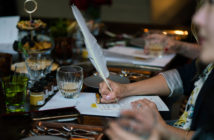Bai Hao Yin Zhen
Silver Needle
白毫银针
A favorite of the “Tea Emperor,” this ancient, top-quality white tea is as beautiful as it is delicious.
Also known as: Baihao Yinzhen, White Hair Silver Needle, White Pekoe Silver Needle
Origin: Northern region of Fujian province in southeast China
Type: Chinese white tea
Appearance: Buds are large, fat, and covered in pale silvery-white fuzz or “down” that resembles tiny hairs; the brewed tea ranges from ivory to a pale honey yellow.
Taste: Smooth, light, fresh, and slightly sweet, without much astringency. Sometimes has a juicy or even citrus undertone reminiscent of tangerine or mandarin orange.
Aroma: Light, sweet, and floral, like fresh wildflowers with a hint of honey.
Varieties: The main varieties of Silver Needle are named for their counties of origin: Zheng He and Fuding. Fuding is the older of the two varieties, known to be cultivated since the 1790s; Zheng He production began around 1880. Both types are produced in similar ways: The fresh young buds, covered in white down, are plucked by hand on only a few sunny days of the year, usually in March or April. The buds are then laid in bamboo baskets to wilt and dry. Silver Needle tea is only slightly oxidized and not fired or fermented, resulting in its light color and delicate qualities. Fuding Silver Needle tends to be lighter in color and body, while Zheng He spends more time withering, resulting in a darker, more oxidized tea. Occasionally, Silver Needle is wilted along with jasmine blossoms, creating a scented Jasmine Silver Needle variety.
Steeping Tips: The white leaves will instantly turn green when infused. White teas can be steeped multiple times; four to six infusions are usually possible.
Typical Preparation: Start by steeping 2-3 teaspoons (about 3-4 grams) per 8 ounces of hot water (approximately 175-180 degrees Fahrenheit) for up to 6 minutes. Don’t use boiling water; the resulting tea will be very yellow and bitter, without any of the delicate flavor of a properly prepared white tea. For later steepings, use the same temperature water, but increase the time based on your personal taste.
Floating Preparation: For an infusion that’s as beautiful as it is tasty, float loose Silver Needle in hot water, either in a glass teapot or simply a glass cup—in China, Silver Needle is often prepared in a tall drinking glass to show off the leaves. The leaves will gently sink to the bottom as they infuse, creating an elegant and delicious experience.
Teaware: Glass teaware best highlights the beauty of Silver Needle tea. However, a traditional gongfu set is also appropriate; try using a Yixing or porcelain teapot or gaiwan.
Trivia: It’s said that the Chinese Emperor Hui Tsung was so obsessed with finding and preparing the perfect Silver Needle tea that he was too preoccupied to keep his empire from being invaded by the Mongols.
What’s All the Fuzz? Silver Needle tea is known for the downy white fuzz all over its large buds. But what’s up with that?
It’s not just white tea: All tea naturally has that fuzzy covering at some point in the growing process. Those little hairs are called trichomes, and they help protect and nurture new leaves on the tea plant. That’s why they show up in your packet of Silver Needle tea; Silver Needle is produced only from the youngest, freshest buds of the Camellia sinensis, delicately harvested by hand and dried with a minimum of fuss and tinkering. That means that the hairs haven’t naturally diminished, as they do on older tea leaves, and they haven’t been rubbed off or removed by a harsh production process.
So embrace that fuzzy cup of tea! All those little hairs prove that your Silver Needle was plucked at the peak of freshness, ready to give you a unique tea experience.
Try:
- Yezi Tea: Silver Needle Bai Hao Yin Zhen
- Art of Tea: Silver Needle
- Red Blossom Tea Company: Organic Fuding Silver Needle, 2013
- Capital Teas: Silver Needles
- Glenburn Tea Direct: Glenburn Silver Needle
This post was previously published in 2013




